On February 23, 2023, B.C. Hydro applied to the B.C. Utilities Commission to introduce Time-of-Use (TOU) Tariffs in British Columbia. The application proposes to allow B.C. Hydro customers to voluntarily opt into TOU pricing, which would take affect in April 2024. Customers opting in will receive a 5-cent/kWh rebate during off-peak hours (23:00-07:00) and a will pay a 5-cent/kWh surcharge during on-peak hours (16:00-21:00). Rates during the other hours (the "shoulder" hours) will remain unchanged. It is important to stress that TOU will remain entirely optional; it will not be the default pricing as in Ontario. Thus, consumers in British Columbia will get more choice, and allows customers to "self-sort" into the most beneficial rate structure. The main target of the TOU program are owners of electric vehicles, who have the ability to program their chargers to commence charging at a specified time.
‘Time-of-Use tariffs incentivize load shifting from on-peak to off-peak hours, especially for EV owners.’
The chart below shows how the new tariff structure works out, in conjunction with the existing two-step tariff (known as an "inclining block structure"). B.C. Hydro's Step-1 tariff applies to the first 1,350 kWh that a household uses in a two-month period (about 22.2 kWh per day), and the Step-2 tariff applies two usage that exceeds this threshold. In 2023, the two rates were set at 9.59 cents/kWh and 14.22 cents/kWh, respectively, a 4.63 cents/kWh difference. Because electricity use in B.C. is seasonal, Step-2 tariff applies more often in the winter than the summer. Households that use more than 22.2 kWh per day will pay the higher marginal rate.
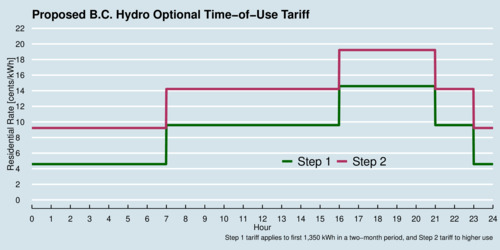
click on image for high-resolution PDF version
The proposed optional TOU has four segments. The overnight segment between 23:00 and 07:00 is the cheapest, with rates below 10 cents/kWh for the Step-2 tariff (maroon-coloured line). Peak prices during the afternoon and early evening, between 16:00 and 21:00, reach just under 20 cents/kWh. What is the rationale for the TOU tariff? The next diagram shows the load profile in British Columbia, averaged over the last four years, for the four seasons. As B.C. is a winter-peaking jurisdiction, the blue line for winter demand stands out strongly.
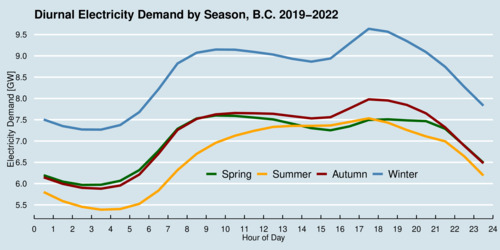
click on image for high-resolution PDF version
Spring and autumn profiles are relatively similar, while load in the summer is typically the lowest. Climate change could change these profiles somewhat. Warmer winters may require less heating, while warmer summers may require more air conditioning. What is noticeable in the winter is the second peak in the afternoon and early evening. There is an increase of about 700 MW in demand from about 3pm to 6pm. This coincides with people getting home from work and turning up the thermostats in for thermal comfort during the cold season. This is the time when the grid is most stressed, and deferring electricity use into the night would be most beneficial in terms of avoided capacity costs.
The 5-cents/kWh differentials are roughly in line with B.C. Hydro's marginal cost. British Columbia's hydro-based electricity system has much less price variation than other jurisdictions, such as Ontario or California.
Time-of-use pricing has been shown to shift energy demand. Consumers are responsive to such incentives, although to varying degrees. Ontario has had TOU pricing for quite some time, unlike B.C. as the default option. The diagram below shows the TOU rates with distinct on-peak prices, shoulder prices, and off-peak prices. Off-peak prices apply overnight between 7pm and 7am, and the shoulder and peak periods switch between summer and winter. In the winter, peak prices are in the morning and early evening, and in the summer peak prices are mid-day between 11am and 5pm.
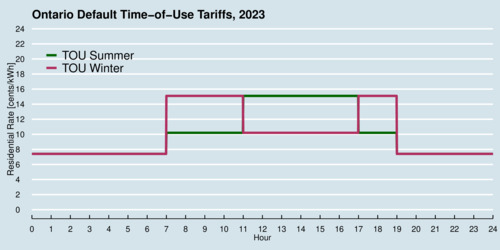
click on image for high-resolution PDF version
Utility customers in Ontario also have the choice of two other rate structures. In order to generate a stronger demand response, customers can opt into an Ultra-Low Overnight (ULO) tariff with much larger variation than the default TOU schedule. The diagram below shows this rate structure. On weekends, customers face a flat rate of 7.4 cents/kWh, while on weekdays customers can get electricity overnight at rates of 2.4 cents/kWh, while facing very high peak prices of 24 cents/kWh between 4pm and 9pm. This encourages even stronger load shifting.
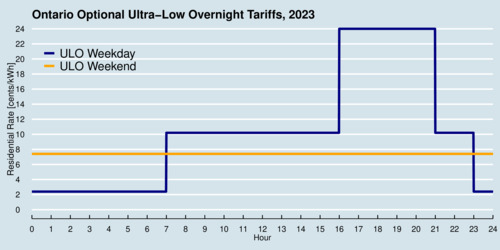
click on image for high-resolution PDF version
Lastly, utility customers in Ontario can also choose a two-tiered monthly-usage tariff that works similar to British Columbia's current tariff. The monthly thresholds are somewhat different and vary by season. The threshold amounts to average use of about 33 kWh/day in the winter and 20 kWh/day in the summer.
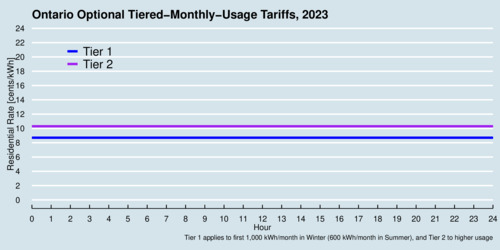
click on image for high-resolution PDF version
Which group of customers is B.C. Hydro targeting with its new Time-of-Use tariff? The answer is: primarily owners of electric vehicles who can defer charging their vehicles to the night. If an EV owner opts into the TOU schedule, they can potentially save money. A typical motorists drives about 40 km/day, which translates into roughly 10 kWh/day of electricity charge. If such an owner shifted all the charging to the night time, an owner would save $182.50 per year. However, the owner would pay a premium for the remaining electricity use during the peak hours. A typical 4-person household like my own uses about 2 kW of power in the late afternoon and early evening, without EV charging. At least this number is a very good approximation of my own household's electricity use. The five-hour peak window under the proposed rate structure would therefore incur an extra cost of $182.50 per year. You see immediately where the problem is. The benefits and costs cancel out, unless the household managed to shift more load from the late afternoon to the late night, which is somewhat unlikely. The new TOU tariff is based on somewhat optimistic assumptions and price elasticities of the ability of households to shift electricity use to the night. Very few appliances can be programmed to run overnight. Thermal comfort offers little scope of postponing load, and hat leaves heavy electricity users such as clothes dryers. But dryers run after a washing cycles, and few people will do laundry in the middle of the night to save electricity costs. There is a notable difference to the TOU scheme in Ontario, where shifting activities to after 7pm is more feasible than shifting activities past 11pm.
So who, then, are the target group of TOU? It is a relatively narrow subset of heavy EV users who drive significantly more than 40 km/day, such as long-distance commuters, and it targets households that already have low electricity demand during the afternoon and early evening, such as one-person or two-person households living in apartments rather than single-detached or single-attached homes. B.C. Hydro's own data (Figure 4-3 in their application) suggest that average electricity use during the on-peak window is 1.4 kilowatts. So the
‘The proposed optional TOU tariff will likely see limited uptake, and there is no economic rationale for adopting it as the default tariff.’
The introduction of optional time-of-use pricing is to be welcomed. More choice is always better than less choice, and the TOU tariff is focused sharply on heavy EV users. Shaving off a little of the expected peak increases due to EV charging may alleviate some of the stress on the electric grid in the winter. While applauding the step that B.C. Hydro is taking, the uptake may be less than what B.C. Hydro is envisioning. The reports that the TOU tariff is relying on, prepared by Ahmad Faruqui, Sanem Sergici and Ryan Hledik of the Battle Group (contained in the BC Hydro application to BCUC as Appendix E and Appendix F) suggests uptake rates between 5-35% based on precedents in other jurisdictions. B.C. Hydro assumes 15% of customers who would be expected to experience bill savings, and about 8% overall among residential customers. My own sense is that there are switching and information costs for utility customers that generally make it difficult to have a clear signal that switching to a TOU tariff would be beneficial for individual customers. The other relevant constraint is that EV owners have access to a smart EV charger, one that can be programmed to commence charging at a specified time.
Despite fears articulated by interveners in the case before the Utility Commission, there is little chance time-of-use pricing will become the default as in Ontario. Time-of-use pricing is not the only option available to B.C. Hydro. They have also been investigating critical peak pricing (CPP), which focuses on situations when the system reaches its capacity limit. As mentioned before, price variation in B.C. is very limited. The objective of the proposed tariff is to incentivize owners of electric vehicles to charge more during the night. However, to make this happen effectively, the current rate structure is not ideal when EV charging is not metered separately. I fully expect that B.C. Hydro's TOU pricing will evolve over time, improving the focus as we learn more about participants' response.